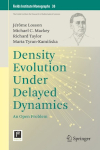- About MAA
- Membership
- MAA Publications
- Periodicals
- Blogs
- MAA Book Series
- MAA Press (an imprint of the AMS)
- MAA Notes
- MAA Reviews
- Mathematical Communication
- Information for Libraries
- Author Resources
- Advertise with MAA
- Meetings
- Competitions
- Programs
- Communities
- MAA Sections
- SIGMAA
- MAA Connect
- Students
- MAA Awards
- Awards Booklets
- Writing Awards
- Teaching Awards
- Service Awards
- Research Awards
- Lecture Awards
- Putnam Competition Individual and Team Winners
- D. E. Shaw Group AMC 8 Awards & Certificates
- Maryam Mirzakhani AMC 10 A Awards & Certificates
- Two Sigma AMC 10 B Awards & Certificates
- Jane Street AMC 12 A Awards & Certificates
- Akamai AMC 12 B Awards & Certificates
- High School Teachers
- News
You are here
Density Evolution Under Delayed Dynamics

Publisher:
Springer
Publication Date:
2020
Number of Pages:
147
Format:
Hardcover
Series:
Fields Institute Monographs
Price:
109.99
ISBN:
978-1-0716-1071-8
Category:
Monograph
[Reviewed by , on ]
Bill Satzer
01/30/2022
“This is a weird monograph to say the least,” as the authors say at the beginning of their Summary and Conclusions chapter. It is indeed unusual, but in intriguing and challenging ways designed to engage readers, especially those with interests in related areas. The book is about how densities evolve under the action of delayed dynamics. Their aim might have been to present theorems with proofs, examples, and applications illustrating how the problem can be solved. But they have no solutions. Instead, this is a monograph describing why the problem is so hard, why they have not solved it yet, and what they have tried so far. They hope to inspire others to take up the challenge.
The authors begin by describing their context for examining the dynamical behavior of a system. Instead of studying the behavior of an individual trajectory, it is often desirable to consider probabilistic or ensemble treatments. While individual systems may have erratic behavior depending on initial conditions, ensemble behavior (developed from a distribution of initial conditions) is generally more regular and its treatment allows one to compute statistical quantities that can be compared to experimental results. An approach like this works for a large class of differential equations, and a variety of methods for handling it have been developed. However, many important biological systems are governed by differential equations with delays. When delays are present there are no existing theoretical methods to describe the evolution of probability densities for the ensemble. Brute force simulation of ensembles for delay differential equations provides evidence of apparent asymptotic stability and asymptotic periodicity, but methods like this rely on inadequate statistical sampling to try to produce acceptable results and are impractically computationally intensive.
The main theme of this book is to try to understand how probabilistic concepts might be applied to the dynamics of delay differential equations. The authors first address basic questions of how a differential delay equation can be interpreted as a dynamical system with a corresponding evolution semigroup, what the phase space is for a system like this, and what an appropriate semigroup is for such a phase space. To simplify their treatment, the authors restrict their attention here to delay equations of the form\( x'(t)=F(x(t),x(t-\tau)) \) where \( x(t) \in R^{n} \), \( F: R^{n} \times R^{n} \rightarrow R^{n} \) and where \( x(t) \) is a continuous function.
The object is to understand how an initial density \( x(t)=\Phi(t) \) with \( t \in [-\tau,0] \) evolves in time. This poses several challenges. One is that the function space to which Φ belongs - continuous functions on \( [ -\tau, 0 ] \) is the natural phase space for differential delay equations of the type described above. But this space carries no natural translation invariant measure that would enable the definition of an appropriate probability density. Another is that none of the existing theories of integration in infinite-dimensional spaces
work here.
The remainder of the book describes possible analytical approaches and methods of approximating solutions. None of these have been successful. The authors take pains to identify what they have found to be blind alleys and to encourage others to develop more promising approaches. There are many opportunities for further research here and many potential thesis problems that might arise from this.
Bill Satzer (bsatzer@gmail.com), now retired from 3M Company, spent most of his career as a mathematician working in industry on a variety of applications ranging from network modeling and speech recognition to material science and the design of optical films. He did his PhD work in dynamical systems and celestial mechanics.
See the publisher's website.
- Log in to post comments




